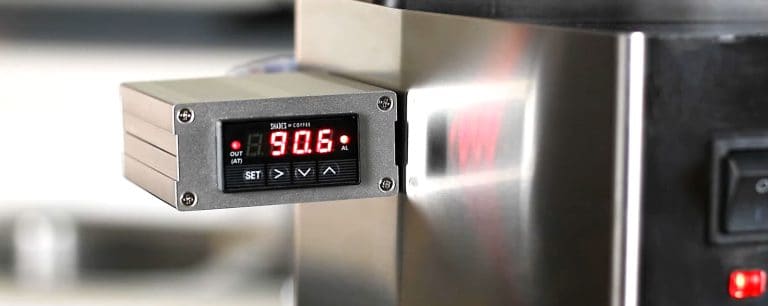Espresso Portafilter Basket Types – Why Are There So Many?
As a barista, I’ve seen and experienced firsthand how each and every component and ingredient can make or break an espresso shot.
Even the portafilter basket comes in different types and sizes, so they have a huge impact on the taste of your espresso. This is why it’s pretty common to have a hard time figuring out which portafilter fits your needs best.
If you’re facing the same dilemma, this article is for you. I’ll tell you all about the variety of portafilters out there and what makes them different from each other.
Portafilter Diameters and Sizes
It’s crucial to use the correct diameter and size basket for your portafilter, otherwise the basket simply won’t fit. Compatibility issues are common with newby home baristas that don’t know any better.
The most common sizes for portafilters are:
- 51 mm – Delonghi machines
- 54 mm – Most Breville-Sage espresso machines
- 58 mm – Professional machines use 58 mm diameter portafilters, while home espresso makers use smaller ones.

Be sure to do research on your specific espresso machine before buying a portafilter to make sure that it’s compatible.
So why the different diameters and how does a 58 mm vs 51-54 mm basket affect the taste, you ask?
Imagine you have a 58 mm coffee basket, which is bigger than other baskets. Because it’s bigger, the layer of tamped coffee grounds is thinner. To make the perfect espresso with 9 bars of pressure, you need to grind the coffee really fine: 0.3 mm or smaller. But here’s the issue: the holes in the 58 mm basket are also 0.3 mm, so some fine coffee grounds end up in your espresso.
Plus, there’s a higher chance of water finding an easy path through the coffee grounds (aka channeling), which can cause uneven extraction. But, on the bright side, using 9 bars of pressure on the thin layer of coffee grounds can make a stronger espresso with the same amount of coffee.
Now, let’s look at the smaller 51 -54 mm baskets. Here, the coffee grounds are packed thicker and taller, and there’s less space for the water to pass through. This makes it better for making a single shot of espresso since it stops water from taking an easy path through the coffee grounds.
There are benefits and drawbacks surrounding both sizes:
| Diameters | Pros | Cons |
|---|---|---|
| Large (About 58 mm) | – More even distribution – Even extraction | – Possibility of channeling higher due to the puck’s larger surface – Not good for single shots |
| Small (54mm and smaller) | – Increased extraction – More compact – Less channeling | – Less yield – Compatible machines are more uncommon – Pucks are harder to knock out of the basket |
So before you decide which is best, know that in Italy (the home of espresso), 90% of all shots are straight single espressos pulled from a single basket with an effective diameter of between 49 mm to 51 mm.
I think the 54 mm portafilter is the most versatile, so it is my main recommendation for home baristas.
Aside from the diameter, there’s also the capacity to consider, which I’ll be touching on next.
Types of Portafilter Baskets
Picking the diameter is just the tip of the portafilter iceberg as there are more features that differentiate these baskets from one another.
Here is an insightful video that you should watch:
Let’s take a look at the types one by one:
Finding The Right Capacity – Single, Double, and Triple Filter Baskets
Capacity is important, as it will depend on how much espresso you want to make in one go. It can also dictate the versatility of your espresso recipes. In this regard, there are three sizes you can choose from.

Single filter basket
This type of portafilter basket is designed for making a single shot of espresso, typically holding around 7 to 12 grams of coffee grounds. So if you like sipping on solo espresso shots at home, this might be the perfect choice for you.
Double filter basket
The double basket holds more coffee grounds at around 14 to 21 grams, allowing you to make two shots of espresso simultaneously. This is great if you want to share your coffee with someone or enjoy a larger cup yourself.
Triple filter basket
With an even larger capacity that goes over 21 grams, a triple basket lets you prepare three shots of espresso at once. If you entertain guests often or have a high demand for coffee in your household, this could be the way to go. I’ve never used one before, they are rare.
To sum it up, finding the right capacity is highly based on your needs. Think about how much coffee you generally consume each day and whether you prefer single or multiple shots in one sitting. You also want to remember that a larger capacity allows for more room to experiment on your brew if you’re just starting out.
Ridged vs Ridgeless Filter Baskets
Choosing between ridged and ridgeless filter baskets might feel like a monumental decision, but truth be told, I don’t see much difference between the two in terms of the resulting cup.

Here is the difference between the two, as I see it:
- A ridged filter basket has an indentation around its circumference which helps keep the basket in your portafilter, providing extra stability for tamping and brewing your espresso.
- On the other hand, ridgeless filter baskets allow you to get your coffee puck out more smoothly, and it’s also easier to clean.
Whichever one you choose between the two, you’ll still be able to pull fantastic shots of espresso with the right technique and attention to detail.
Precision / Competition Filter Baskets
Graduating to precision or competition filter baskets is worth giving a shot for that next-level espresso experience. But before you do, make sure you are perfect at dialing in your espresso, otherwise there is no point in the upgrade of the basket.
These baskets are designed to deliver the highest level of consistency and quality in your extractions. It’s often used in professional barista competitions and commercial espresso machines.
The quality of the basket is influenced by :
- the number of perforation holes on its surface,
- the polishing of the bottom and top surface areas,
- and the uniformity of the perforation holes.
A key feature is their precisely engineered hole pattern and size. This helps ensure an even extraction across the entire coffee puck. I also encourage the use of a bottomless portafilter with these baskets for better control over your technique as well as the ability to judge your brewing process by sight.
So once you think you’re ready to level up your espresso game, I recommend that you consider investing in a precision or competition filter basket.
You will be surprised at how inconsistent the machining of the holes is with lower grade baskets. Try it! Hold yours up to a light source, and you’ll see the consistency of the holes.

Understanding Pressurized vs Non-Pressurized Baskets
Another important decision in making your espresso is whether you should use non-pressurized or pressurized filters.

Pressurized portafilter baskets are designed to create optimal pressure within the basket by using a double-wall design that restricts the flow of water through the coffee grounds, allowing for more forgiveness on your misses in terms of coffee quality, grind size, and tamping.
Pressurized portafilters are great for beginners or those who want an easier time pulling consistent shots without having to worry too much about perfecting grind size and tamping. You can even use pre-ground coffee with it.
Then there’s the non-pressurized basket which offers experienced home baristas greater control over the extractions. It allows you to fine-tune variables such as grind size, dose, and tamping pressure to get the perfect brew for your specific taste.
In short, if you want the easier route in brewing espresso, go for the pressurized variant but if you value versatility in your brew, a non-pressurized basket is for you.
Spouted Portafilters vs Naked Portafilters
Let’s talk spouted and naked portafilters. To put it simply, a spouted portafilter has one or two spouts attached to its bottom, which direct the flow of espresso into your cup.
The main advantage of a portafilter with two spouts is that you could pull shots of espresso into two different cups placed beneath each spout. However, I don’t really see much benefit from using a single spout, even though many cafés use it.
As for the bottomless or naked portafilter, it lets you observe the extraction as it happens before dripping into your cup.

I like this way better than its spouted counterpart because of its multiple advantages:
- You can easily spot inconsistencies or mistakes in tamping and address them accordingly.
- The way the espresso flows from beneath the portafilter is such a marvelous sight.
- It’s easier to clean because spouts can make more residue buildup.
- More crema forms in your drink as spouts interfere with its formation upon pulling your shot. Click here for more reasons why you might have less crema in your espresso.
So unless you often have to make two separate cups of espresso in one pull, I recommend that you go for the naked portafilter for better results.
Tips for Selecting the Right Portafilter and Basket
When you’re choosing the perfect portafilter and basket, here are the key factors you want to consider when making that decision:
- Compatibility – Make sure the portafilter and basket are compatible with your machine to ensure a proper fit and optimal performance.
- Material quality – Choose a high-quality material like stainless steel to ensure durability and prevent contamination.
- Handle design – Look for a comfortable and ergonomic handle that allows for a secure grip and easy maneuvering.
- Number of spouts – Decide whether you need a single or double spout based on your preferences and the volume of espresso you plan to make.
By finding the right balance of these characteristics, it’s easier to pull that perfect espresso shot.

Portafilter Accessories
You also want to check out some accessories to ensure that your use of the portafilter and basket is precise and perfect:
- Dosing cups: measuring cups used to ensure consistent amounts of coffee grounds are added to the portafilter.
- Dosing funnels: a tool used to guide coffee grounds into the portafilter without making a mess.
- Distribution stirrers: used to evenly distribute coffee grounds in the portafilter to ensure even extraction.
- WDT tool: a set of needles used to break up clumps in the basket.
- Pressure gauges: devices used to monitor the pressure of the espresso machine to ensure optimal extraction.
With these accessories, you’ll be able to improve your dosing, distribution, and pressure control like a breeze.
Cleaning and Maintaining Your Portafilters & Baskets
As with all of your brewing equipment, maintaining the cleanliness of your portafilters and baskets is really important. A dirty or damaged portafilter can ruin an otherwise perfect shot of espresso.
Here’s how you can clean and keep your portafilter and baskets in tip-top shape:
- After each use, remove any remaining grounds from the filter basket by tapping it on a knock box.
- Rinse the basket under running water to remove any additional debris.
Occasionally, you will want to do a deeper cleaning as well:
- Soak it in hot water with detergent or a specialized coffee machine cleaner for 15 minutes to remove coffee oils.
- Rinse thoroughly after cleaning to avoid leaving soap residue that could affect the taste of future shots.
As with most equipment, regular maintenance and care extend its lifespan. By taking proper care of your portafilter and baskets, you ensure that they will last longer and function better over time.
FAQ
There is a long clip-like metal rod bent around the inside of the portafilter, which keeps the basket inside by applying pressure around the basket.
Most traditional steel baskets are also dishwasher safe, but always read the manufacturer’s instructions for specific guidelines. The handle might not like the dishwasher.
However, if you’re using non-stick, coated baskets like those found in pressurized systems, do not put them in the dishwasher as this will damage the coating over time
High-flow and low-flow baskets pertain to the type of baskets used in lever espresso makers by Flair. High flow baskets require precise grind size and puck preparation but they can maximize extraction for finely ground coffee. Low flow baskets add resistance and can be more forgiving with coarser grinds, making them the better choice for lighter roasts.
Summary
With the perfect portafilter and basket, you’re set to make espresso shots that not only please the palate but also fit your needs and lifestyle.
Making that choice might seem overwhelming at first, but with enough knowledge, it can be easy picking the one that’s right for you. I know because I’ve been there. Being clueless is not bad, but knowing what you need from the get-go offers a huge advantage.








